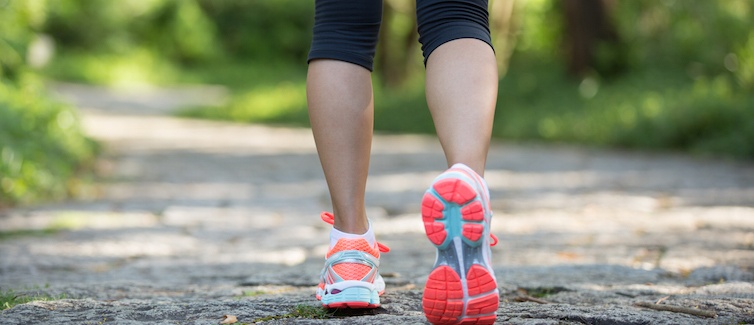Everyone loses bone density as they age. However, if you lose too much, you can develop osteoporosis— also known as “brittle bones.” Osteoporosis puts you at risk for fractures, especially in your wrists, hips, and spine. Fortunately, certain forms of exercise can help develop strong and healthy bones and reduce your risk of osteoporosis.
Facts About Osteoporosis
Instead of being solid and dense, bones with osteoporosis become thinner and develop a honeycomb-like appearance. It can happen to both men and women, usually over the age of 50. However, it’s far more common in women because they tend to have smaller, thinner bones.
According to the National Osteoporosis Foundation, other risk factors include:
- Having a family history of osteoporosis.
- Having a small, thin frame.
- Smoking cigarettes or being a heavy drinker (more than two drinks per day for women or three per day for men).
- Going through menopause.
- Having certain health conditions, including thyroid disease, celiac disease, diabetes, eating disorders, rheumatoid arthritis, and inflammatory bowel disease.
- A diet that’s low in calcium, vitamin D, and foods that supply bone-building vitamins and minerals.
- Not getting enough exercise.
Never Miss a Beat!
Subscribe to Our HealthBeat Newsletter!
Thank you for subscribing!
You can now select the specific newsletters you'd like to receive.
You are already subscribed.
Subscribe to more newsletters in our email preference center.
Sorry, an error occurred. Please try again later.
Get Healthy Tips Sent to Your Phone!
How Exercise Helps With Bone Health
Bones are living organs. They’re constantly changing as your body breaks down old bone tissue and replaces it with new tissue. The process is very efficient when you’re young, but around the age of 30, you gradually start to lose more bone tissue than you make.
The good news is that, just like with muscles, you can build and strengthen your bones with exercise. This slows down the rate of bone loss as you age. On the flip side, bones become weaker and break down faster if you’re inactive. Exercise increases bone density because when you put stress or force on your bones, they adapt by creating more cells, which helps to strengthen existing bone tissue.
The Best Exercises for Bone Health
All types of exercise have benefits for your health. However, the best activities for bone health are weight-bearing exercises that force you to work against gravity. Some good weight-bearing exercises include:
- Walking.
- Jogging.
- Hiking.
- Jumping rope.
- Playing tennis or pickleball.
- Golfing, if you’re walking the course. (Extra points if you carry your bag!)
- Climbing stairs.
- Dancing.
Non-weight-bearing exercises like swimming, water aerobics, biking, or using an elliptical trainer are still good for you. They’re just not the best choices to strengthen your bones.
The downside of weight-bearing exercise is that it can put extra stress on your joints, so it’s essential not to overdo it. While you’ll get the most bone-building benefit from more strenuous exercise, lower impact exercises like brisk walking can help maintain bone density.
Add Some Strength Training
In addition to weight-bearing exercise, resistance or strength-training exercises can also build up your bones. You should consider including them with your weekly exercise routine. These exercises include Pilates, lifting weights, or doing resistance exercises against your body weight, like planks, pushups, or squats. Since your bones are attached to muscles, strength-training exercises also put force on your bones, which in turn helps to strengthen them.
Experts agree that combining weight-bearing with strength-training exercise provides the best results for preventing age-related bone loss. A good goal is to engage in at least 150 minutes of weight-bearing exercise, plus two to three sessions of strength training, each week for best results. Be sure to target all parts of your body.
Finally, as you age, balance and coordination can decline, and that creates a significant risk for trips or falls and broken bones. It’s best to include workouts that involve balance, coordination, and focus, such as yoga or tai chi. This will provide further benefits and complement your exercises for bone health.
Before starting any exercise program, it’s vital to get the green light from your health care provider. It’s also a good idea to work with a personal trainer for at least a few sessions to make sure you’re working out properly.
To learn more about bone health or to schedule an appointment with UPMC Orthopaedic Care, please call 1-866-987-6784 or visit UPMC.com/Ortho.
Sources
Who Gets Osteoporosis? Osteoporosis Foundation. https://cdn.nof.org/wp-content/uploads/Who-Gets-Osteoporosis-BONE-BASICS.pdf
The Effectiveness of Physical Exercise on Bone Density in Osteoporotic Patients. BioMed Research International.
https://www.ncbi.nlm.nih.gov/pmc/articles/PMC6323511/
Exercise for Your Bone Health. Institutes of Health Osteoporosis and Related Bone Diseases National Resource Center.
https://www.bones.nih.gov/health-info/bone/bone-health/exercise/exercise-your-bone-health
About UPMC Orthopaedic Care
When you are dealing with bone, muscle, or joint pain, it can affect your daily life. UPMC Orthopaedic Care can help. As a national leader in advanced orthopaedic care, we diagnose and treat a full range of musculoskeletal disorders, from the acute and chronic to the common and complex. We provide access to UPMC’s vast network of support services for both surgical and nonsurgical treatments and a full continuum of care. Our multidisciplinary team of experts will work with you to develop the treatment plan that works best for you. Our care team uses the most innovative tools and techniques to provide better outcomes. We also are leaders in research and clinical trials, striving to find better ways to provide our patients care. With locations throughout our communities, you can find a provider near you.
